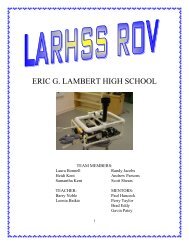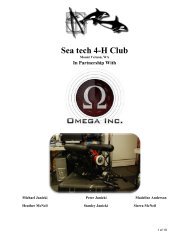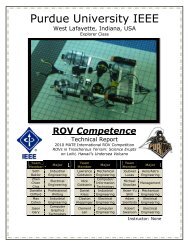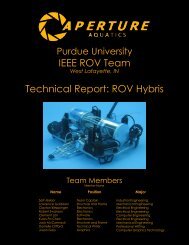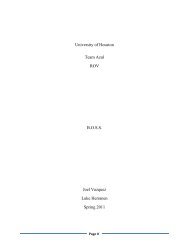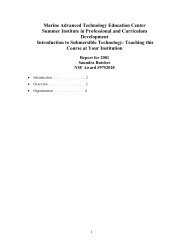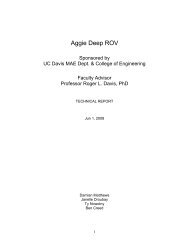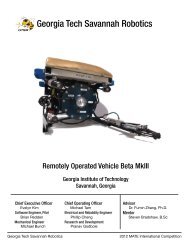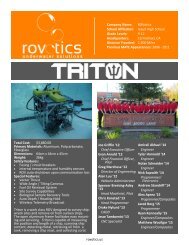technical report - the Marine Advanced Technology Education (MATE)
technical report - the Marine Advanced Technology Education (MATE)
technical report - the Marine Advanced Technology Education (MATE)
You also want an ePaper? Increase the reach of your titles
YUMPU automatically turns print PDFs into web optimized ePapers that Google loves.
Lift Bag<br />
Hydrostatic uplift of <strong>the</strong> lift bag is<br />
created and regulated by <strong>the</strong> volume of <strong>the</strong><br />
fluid, which is forced by <strong>the</strong> airbag, placed<br />
in it. Lift bag design is presented in <strong>the</strong> form<br />
of a soft elastic airtight shell, placed in a<br />
sturdy loose-fitting grid. The elastic shell<br />
has a nipple with back valve for pumping<br />
and draining air. The underwater cargo<br />
should be attached by <strong>the</strong> grid. Pumping is<br />
performed with <strong>the</strong> use of airlift pump,<br />
which is used in <strong>the</strong> removal of oil from <strong>the</strong><br />
tanker. The proposed construction of <strong>the</strong> lift<br />
bag is technologically simple and easy to<br />
manufacture. It does not require <strong>the</strong> use of<br />
expensive materials and equipment. You<br />
can find more information about Lift bag in<br />
“Engineering Evaluation” part.<br />
It is known, that <strong>MATE</strong> Center, with<br />
<strong>the</strong> support from SUBSALVE USA<br />
(www.subsalve.com), will provide 25 pound<br />
lift bag to any EXPLORER class company.<br />
Alternatively companies are free to engineer<br />
or purchase its own lift bags. The weight of<br />
<strong>the</strong> EXPLORER class mast is between 50 and<br />
75 Newton (in water). BMSTU team will be<br />
able to use its own lift bag, as well as a lift<br />
bag provided by <strong>MATE</strong>C.<br />
Oil extractor<br />
For <strong>the</strong> removal <strong>the</strong> oil from <strong>the</strong><br />
tanker and its replacement with <strong>the</strong> salt<br />
water, we are using a special device (Fig.<br />
15). It consists of two fairly solid, but<br />
flexible polymer extractor tubes directed<br />
vertically downward. It also has conical<br />
hopper-catchers and inflatable torus elastic<br />
elements fitting <strong>the</strong> free ends of <strong>the</strong> tubes.<br />
At first, hopper-catchers are used.<br />
They make it easy to align <strong>the</strong> extractor tube<br />
in <strong>the</strong> holes. Fur<strong>the</strong>r, a solid plastic tip tube<br />
acts as a drill, penetrating through <strong>the</strong><br />
plugging layer of petroleum jelly. When <strong>the</strong><br />
pilot decides that <strong>the</strong> drilling is completed,<br />
and <strong>the</strong> tubes are immersed in <strong>the</strong> hole<br />
deep enough, rubber bags, which are<br />
slightly above <strong>the</strong> tip, are filled with <strong>the</strong> air.<br />
All above mentioned elements create an<br />
interconnected system, which consists of a<br />
tank vessel, inlet and outlet pipes going<br />
along <strong>the</strong> ROV’s cable, and <strong>the</strong> tank on <strong>the</strong><br />
surface. The surface tank has a movable<br />
partition, and is initially filled with <strong>the</strong> salt<br />
water. When <strong>the</strong> partition is set in motion,<br />
<strong>the</strong> salt water begins to fill <strong>the</strong> tube leading<br />
into <strong>the</strong> outflow port. At <strong>the</strong> same time, low<br />
pressure zone is formed in ano<strong>the</strong>r tank<br />
cavity, thus starting <strong>the</strong> pumping of <strong>the</strong> oil.<br />
Rubber bags’ inflating mechanism is also<br />
located on <strong>the</strong> surface and consists of a<br />
syringe with air.<br />
Fig. 15 Oil extractor<br />
15



